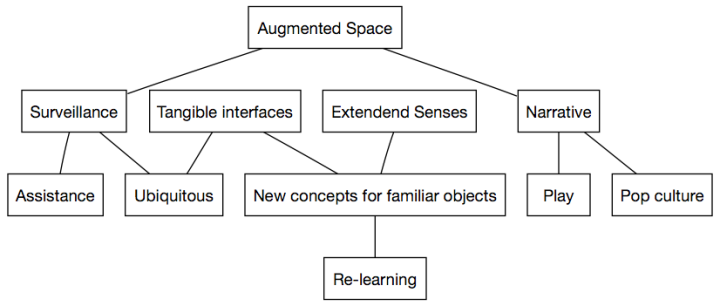
Key Concepts
* Create a new space for interpersonal interaction. * Highlight the gap between the reality and perception. * The hardware is "compatible" with human behaviour and the way most of human perceptions operate (can learn, can be ignored - not annoying, interactions are not too visible to others)
Augmented Space
The term Augmented Space, introduced by Lev Manovich in his Essay "Augmented Space: Learning from Prada", describes overlaying layers of data over the physical space. We situate the project in this context because the space which we use for our network is a very restricted one, that under normal circumstances fulfills the function of drinking a cup of coffee or in the best case work or meet there. Nowadays this place is filled with various kinds of social or unsocial networks. We add a more ubiquitous one to this space of networks, which according to Manovich always oscillates between surveillance and assistance. Extended senses
* Advanced technology allows to sense what was not accessible before * Realtime telesensing opens opportunities for new modes of interaction * Leads to new behavioral patterns and associations * Creates a language and a framework for evaluating these kinds of interactions * Not focused on exclusive visual interaction, rather on sensory modes that are more often processed subconsciously and thus much more directly connected to emotional response.
Tangible Interfaces
* Infuse new meaning into everyday things * Force both conscious and subconscious evaluation of familiar concepts * Emphasize the gap between perception and reality -> Augmented spaces * Force relearning thus leading to new -> extended senses, behavioral changes – new patterns
The coffee cup is an unlikely source of a human-computer interaction. It is representing the data using the extended capabilities of a familiar object. Instead of using traditional means of interfacing with a digital world (such as using a mouse or keyboard), this project explores the idea of sending and receiving messages using the capabilities of touch through the surface of a coffee cup. This product calls us to go outside traditional modes of interaction and communication, but yet at the same time allows us to feel the comfort of using a familiar object as a medium of communication. Although the user can control the direction of the cup and the pressure sent to the surface of the cup through the grip of a hand, the user also has control over the digital world using the lips.
Narrative
* People create stories to fill in gaps of the unknown * Ubicup exposes a lot more unknown * Potential for play and exploration * Potential for creative behavior due to randomization and new possibilities
